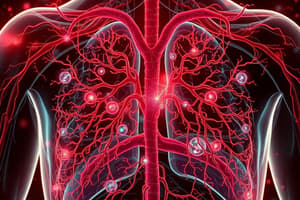Podcast
Questions and Answers
What percentage of gas exchange occurs in the alveoli?
What percentage of gas exchange occurs in the alveoli?
- 50%
- 60%
- 80%
- 70% (correct)
What is the primary role of type 2 pneumocytes in the alveoli?
What is the primary role of type 2 pneumocytes in the alveoli?
- Forming the respiratory membrane
- Monitoring microbial presence
- Producing surfactant (correct)
- Facilitating oxygen diffusion
Which structure does NOT participate in gas exchange?
Which structure does NOT participate in gas exchange?
- Alveolar sacs
- Conducting zone (correct)
- Respiratory bronchioles
- Alveolar ducts
What type of epithelium makes up the type 1 pneumocytes?
What type of epithelium makes up the type 1 pneumocytes?
What is the significance of the respiratory membrane being thin?
What is the significance of the respiratory membrane being thin?
What is the primary function of ventilation in the respiratory system?
What is the primary function of ventilation in the respiratory system?
Which process describes the transport of respiratory gases in and out of the blood?
Which process describes the transport of respiratory gases in and out of the blood?
What must be appropriately matched to ensure efficient respiration?
What must be appropriately matched to ensure efficient respiration?
What are the two major systems of the respiratory system?
What are the two major systems of the respiratory system?
What anatomical feature helps keep the airways open in the respiratory system?
What anatomical feature helps keep the airways open in the respiratory system?
Which part of the respiratory system is primarily responsible for gas exchange?
Which part of the respiratory system is primarily responsible for gas exchange?
What does internal respiration specifically involve?
What does internal respiration specifically involve?
Which structure is at the beginning of the conducting zone in the respiratory system?
Which structure is at the beginning of the conducting zone in the respiratory system?
Flashcards
Respiratory Processes
Respiratory Processes
The four stages needed for proper oxygenation of blood and tissue perfusion: ventilation, external respiration, transport, and internal respiration.
Ventilation
Ventilation
The process of moving air into and out of the lungs, including breath rate and volume.
External Respiration
External Respiration
Gas exchange between lungs and blood across the respiratory membrane.
Transport
Transport
Signup and view all the flashcards
Internal Respiration
Internal Respiration
Signup and view all the flashcards
Conducting Zone
Conducting Zone
Signup and view all the flashcards
Respiratory Zone
Respiratory Zone
Signup and view all the flashcards
Alveoli
Alveoli
Signup and view all the flashcards
Alveoli gas exchange
Alveoli gas exchange
Signup and view all the flashcards
Respiratory membrane
Respiratory membrane
Signup and view all the flashcards
Type 1 pneumocytes
Type 1 pneumocytes
Signup and view all the flashcards
Surfactant
Surfactant
Signup and view all the flashcards
Partial Pressure
Partial Pressure
Signup and view all the flashcards
Study Notes
Respiratory System Processes
- Four processes are crucial for proper blood oxygenation and body perfusion: ventilation, external respiration, transport, and internal respiration.
Ventilation
- Involves rate and volume of air movement into and out of lungs.
- Measured as respiratory minute volume.
External Respiration (Alveolar Ventilation)
- Gas exchange between blood and alveoli across respiratory membranes.
- Also known as alveolar ventilation.
Transport
- Movement of blood and respiratory gases throughout the body.
- Dependent on cardiac output.
- Must be coordinated with ventilation.
Internal Respiration
- Gas exchange between blood and tissues.
- Ensures tissues receive adequate oxygen for cellular processes.
Lung Anatomy
- Air passages begin at external nares, leading through nasal cavity, larynx, trachea, and to alveoli.
- Lungs are within separate pleural cavities in the thoracic cavity.
- Mediastinum separates the pleural cavities.
- Airway structures, such as those in the larynx, must remain open to minimize resistance.
- Cartilage supports these structures.
- Two major systems: conducting zone (airway purification and conditioning) and respiratory zone (gas exchange).
- Conducting zone includes nasal cavity, pharynx, larynx, trachea, primary, secondary, and tertiary bronchi, bronchioles, and terminal bronchioles
- Respiratory zone includes respiratory bronchioles, alveolar ducts, alveolar sacs, and alveoli.
- Alveoli are the primary site of gas exchange (70%).
Respiratory Membrane
- Lines alveoli; it must be thin for efficient gas exchange (oxygen and CO2 diffusion).
- Composed of type I pneumocytes (simple squamous epithelium), thin fused basement membrane, and endothelial cells of pulmonary capillaries.
- Type II pneumocytes produce surfactant, preventing alveolar collapse.
- Macrophages monitor and remove microbes and particles in alveoli.
Partial Pressure
- Describes the proportion of a gas component in a mixture.
- Atmospheric pressure is influenced by percentages of N2, O2, H2O, and CO2.
- Differences in partial pressures drive gas exchange.
Ventilation Rate
- Average rate is 12-20 breaths per minute (~1 breath every 5 seconds).
- A crucial functional residual capacity (FRC) of air remains in the lungs even after exhalation which helps to maintain consciousness and adequate oxygen levels during breath holding.
Neural Circuits and Ventilation
- Stretch receptors in lungs and chemoreceptors in carotid and aortic bodies monitor lung fill levels and blood CO2 levels respectively.
- Inflation reflexes adjust ventilation subconsciously to maintain optimal levels.
- Blood CO2 largely regulates ventilation rate.
- High CO2 (hypercapnia) increases ventilation, while low CO2 (hypocapnia) decreases ventilation.
- Hypoxemia (extremely low O2) also triggers an increase in ventilation rate, but only at very low levels.
Muscular Control of Ventilation
- Normal ventilation relies on diaphragm and external intercostal muscles.
- Forced ventilation involves additional accessory muscles (e.g., sternocleidomastoid, scalenes).
Respiratory Minute Volume
- A variable reflecting how well the respiratory system matches blood oxygenation and tissue metabolic requirements.
- Tidal volume (the amount of air inhaled/exhaled during normal breathing) multiplied by the ventilation rate.
- A precise relationship is maintained between this volume, our breathing actions, and levels of our blood carbon dioxide and oxygen concentrations(O2 and CO2).
Studying That Suits You
Use AI to generate personalized quizzes and flashcards to suit your learning preferences.




